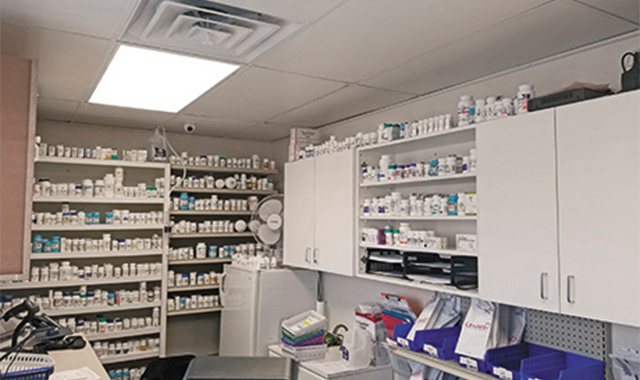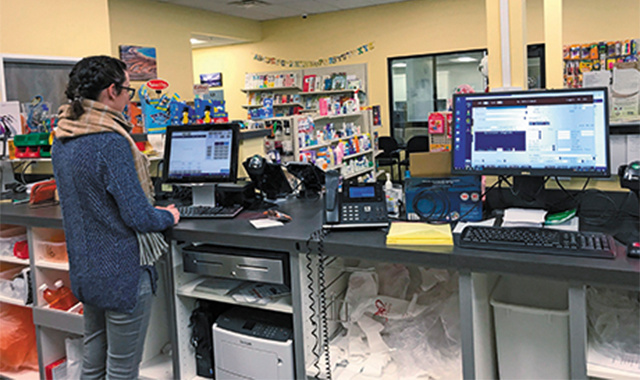Telepharmacy's New Frontiers Expand Business Opportunities
Rural markets pave way to treat underserved populations, provide value-based care, and expand prescription volume.

Micah Pratt's tele pharmacy setup is used to serve a community 30 miles from his retail operation.

Sally Myer in Victor, ID, helped stave off imminent competition with this setup.

When North Dakota opened the nation’s first community-pharmacy-based remote dispensing site in 2001, the case was simple. The state pharmacy association, board of pharmacy, and pharmacists wanted to reverse the tide of rural communities losing pharmacy services. The pilot program brought pharmacy services to 80,000 rural North Dakotans who were without a pharmacy.
Nearly two decades later, the case for telepharmacy is more inclusive. The goal is to bring pharmacy services to underserved areas. Telepharmacy can work in rural or urban settings, specialty clinics, hospitals, or anywhere else that needs but does not have ready access to pharmacist care.
That led Heather L. Bibeau, PharmD, director of outpatient pharmacy services at Bigfork Valley Hospital in Minnesota to open telepharmacies in three Federally Qualified Health Center clinics in Bigfalls, Floodwood, and Northome, MN, which had no community pharmacies in 2017. The state’s newest telepharmacies join 19 other remote dispensing facilities.
The latest move is bringing telepharmacy to underserved urban areas that lack a conventional brick-and-mortar pharmacy.
Meeting Unmet Needs
“There is a shift of telepharmacies for strictly rural areas to telepharmacies for medically underserved areas in urban settings, where patients may have transportation issues, may be low income, and not have a convenient pharmacy,” said Adam Chesler, PharmD, director of regulatory affairs for Telepharm, a telepharmacy software provider owned by Cardinal Health.
Cardinal Health has identified multiple areas where a patient might need to take two or more buses to get to their doctor, then another two or three more to get to the nearest pharmacy, he said. The focus is increasingly on providing access wherever it is needed.
Read More: Resources for Getting Started with Telepharmacy
Pharmacists are identifying other needs that telepharmacy can meet. In West Texas, Micah Pratt, PharmD, needed a way to ease the skyrocketing costs of delivering medications to patients in Olton, about 30 miles from his pharmacy in Littlefield. He gained patients after a national chain bought out the sole pharmacy in Olton, closed the store, and moved prescriptions to an existing pharmacy another 30 miles away that did not offer delivery. With up to 25 deliveries to Olton daily, Pratt saw profits falling as delivery costs climbed.
In 2016, Pratt opened the first telepharmacy in Texas to give his Olton patients a local pharmacy outlet and provide a base for local deliveries. And to discourage potential expansion by the chain that had closed Olton’s brick and mortar pharmacy.
In Driggs, ID, Sally Myler, PharmD, wanted to expand to Victor, a nearby town that is small but growing as a bedroom community to nearby Jackson Hole, WY. And she wanted to deter an aggressive chain had already tried to buy out her third-generation Corner Drug, then threatened to undercut her prices and hire her employees when she declined to sell.
Telepharmacy helped Pratt and Myler move ahead of the competition. Both use Telepharm as their telepharmacy software provider, but their business models differ.
Pratt set up shop in what had been a large closet in a medical clinic in Olton, about 150 square feet. Existing Texas legislation allowed telepharmacy, but requirements were so onerous that no one had successfully opened a remote dispensing location. He spent months working with the Texas Board of Pharmacy to obtain waivers to open the remote location, then more months with the state legislature to create a more workable legislative framework for telepharmacy.
With more favorable regulation in place, Pratt purchased a second brick and mortar pharmacy and opened a second telepharmacy. Texas allows up to two remote dispensing locations for each brick and mortar pharmacy and he is actively looking for two more telepharmacy locations.
Myler considered moving into the existing medical clinic in Victor, in a converted modular home. Instead, she worked with the clinic to build Victor’s first purpose-built medical facility. The clinic is her primary tenant and the building includes pharmacy space.
Victor is growing, like much of rural Idaho, which could improve prescription volume as well as front-end sales. At some point, it could make sense to convert the telepharmacy to a second brick and mortar pharmacy. Myler told Drug Topics that local real estate brokers warned that other operators were looking for pharmacy space, including Victor’s one grocery store.
“If we hadn’t come into Victor, it was clear that somebody else would,” she said, “either as a telepharmacy or a brick and mortar pharmacy. Either way, we would have lost the customers that are keeping our Victor outlet going.”
Pharmacy Employment
Early doubters called telepharmacy a job killer. It hasn’t happened in North Dakota, which has more experience with telepharmacy than any other state.
“Telepharmacy is almost exactly the opposite [of a job killer],” said Mark Hardy, executive director of the North Dakota Board of Pharmacy. “We’ve never seen a situation where a pharmacist has been displaced because of telepharmacy. We see more of an expansion of services and employment for both pharmacists and technicians.”
APhA Is Bullish
“Telepharmacy allows for new job opportunities for pharmacists,” said Jennifer Bingham, PharmD, BCAP, chair of APhA’s 2018-2019 Special Interest Group. “With the healthcare landscape shifting toward value-based care, it is a great opportunity for our profession to expand our services to provide more comprehensive patient care that can improve patient satisfaction. Knowing that telepharmacy can be used to drive new revenues and patient acquisition, the possibilities are endless.”
Business First
Telepharmacy is just as much a business as a brick-and-mortar pharmacy. The brick-and-mortar pharmacy has a pharmacist on the premises to oversee dispensing, counsel patients, provide advice, and answer questions. The telepharmacy pharmacist does precisely the same things, but from a remote location.
The brick-and-mortar pharmacy needs sufficient prescription volume to justify the expense of a pharmacist. Telepharmacy allows a pharmacist to share time across multiple lower volume pharmacies.
“A lot of the communities we are in can’t support the salary of a pharmacist,” said Jeff Shorten, PharmD, director of pharmacy operations for regional chain Thrifty White Pharmacy. Eleven of the chain’s 97 pharmacies are telepharmacies in North Dakota and Minnesota. “But they can provide enough volume to support a telepharmacist. We have pharmacists who are specifically telepharmacists helping these smaller communities. But it’s not a lucrative business model for us.”
Trending: Coping with Patient Death
The break-even point for telepharmacy depends on location, but 30 to 45 scripts per day usually covers fixed costs such as technician staff, building, hardware, software, inventory, and other location-specific items.
“At 40 scripts per day, we’re not really paying back the pharmacist’s time that is going into the telepharmacy,” said Brett Barker, PharmD, vice president of operations for NuCara Pharmacy, a 24-store regional chain that piloted two of the first telepharmacies in Iowa. The company now has five telepharmacies in North Dakota and Iowa.
“We want to get to 50 or 60 scripts per day to pay back the pharmacist’s time. The goal is to extend the reach of our pharmacists to places we wouldn’t otherwise be able to place them. We’d love it if we could grow them all to the point that the pharmacist is physically there full-time, but telepharmacy gives us a way to start in places where patients otherwise don’t have local access to pharmacists.”
Telepharmacy location depends largely on local needs and availability. Thrifty White and NuCara use free-standing locations, but other telepharmacies operate in clinics, grocery stores, almost any location that can meet local regulatory requirements.
That flexibility gives regional chains and independent pharmacies a competitive edge. National chains and big box stores rely on standardized procedures. A pharmacy with 5,000 similar stores isn’t going to deviate significantly for pharmacy 5,001.
“CVS isn’t going to build a pharmacy in a town of 1,000 people,” Shorten said. “And if the town isn’t big enough for a Walmart, they’re probably not going to put a random pharmacy in there. At the same time, as community pharmacies continue to be squeezed by thinning margins, there will be more and more pharmacies that are no longer viable as a traditional pharmacy with a pharmacist on site. That’s only going to increase the opportunity and the need for telepharmacy.”

Pharmacists Play Unique Role in Advancing Health Equity for Patients With Chronic Disease
December 7th 2023A new study, outlined in a poster at ASHP Midyear 2023, identified 3 key themes associated with the ways in which pharmacists are positioned to advance health equity for patients with chronic diseases.
Assessing Financial Impacts of Pharmacist-Led Interventions in Pediatric Ambulatory Care
December 5th 2023According to a poster abstract presented at the ASHP Midyear Clinical Meeting & Exhibition, specialty pharmacy services were used for a variety of conditions that have been reported in adult populations.